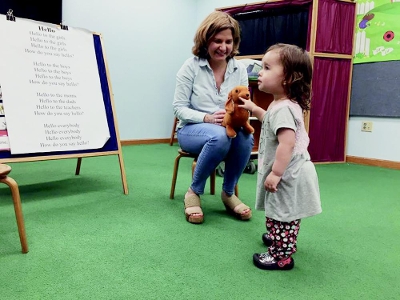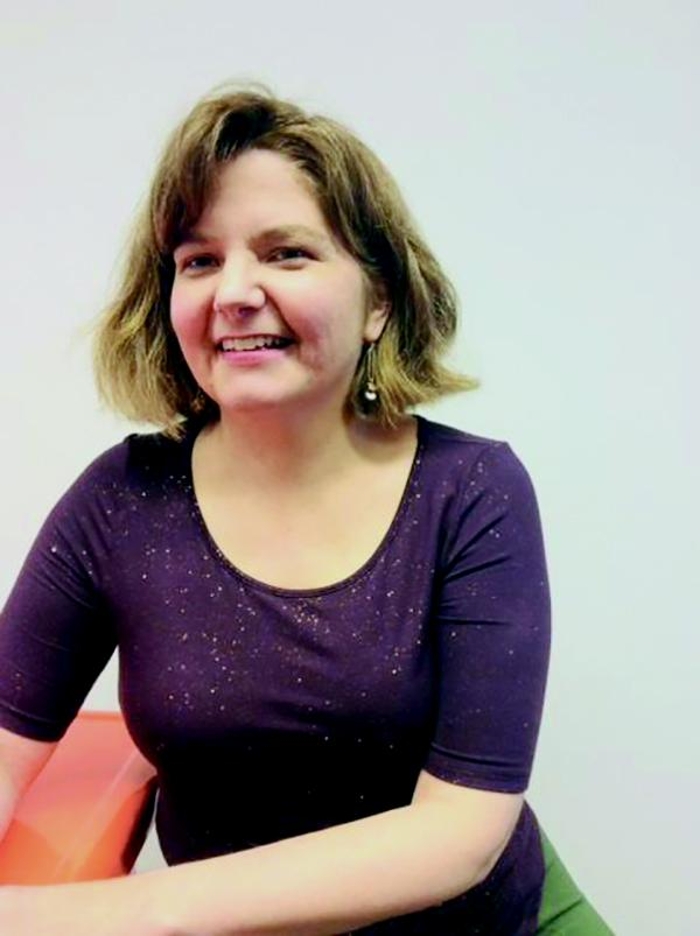How a Prelingual Deaf Child Learned to Love Books
There have been several major studies in recent decades about the benefits of reading picture books to profoundly deaf children with delayed literacy skills. Often, the kids are compared to their average-hearing peers, and, though this may be perplexing to some, their skills have not been found wanting.
There have been several major studies in recent decades about the benefits of reading picture books to profoundly deaf children with delayed literacy skills. Often, the kids are compared to their average-hearing peers, and, though this may be perplexing to some, their skills have not been found wanting. Cheri L. Williams and Mari M. McLean’s “Young Deaf Children’s Response to Picture Book Reading in a Preschool Setting” (1997) concluded that
despite severe language delay, the deaf children’s responses to picture book reading events were very similar to hearing children’s responses, and that the deaf children were learning a great deal about what reading is and how it is accomplished through these picture book reading events.
This is no surprise to me, born profoundly deaf in 1969. A pulmonary disability (also caused by a birth defect) and attempts to restore my hearing kept me in and out of hospitals and frequently changing schools. Not a recipe for academic success!
It was not until approximately age seven that I began recognizing letters of the alphabet. A pediatrician, following the predominant belief of the day, advised my parents not to teach me American Sign Language (ASL) or to learn it themselves. It was thought that if I learned ASL I’d never speak English. The objective of my brutal oral education was assimilation. (Sadly, this ideology still exists for many deaf kids of hearing parents today.) My family instead created “home sign,” our own system of gestures and expressions to communicate, until I began speech therapy and followed a wobbly road to literacy.

The author watching TV upside-down.
While home sign is often described as “crude,” my parents (and to a lesser degree my older brother Peter) were highly inventive and crucial. My feelings of alienation would be difficult to overestimate. Prelingual deafness produces a mark that can never be washed away, a mark that is only discernible to others who are alike. I was a head banger. The rhythm soothed me, and an afterschool gymnastics program created a nonverbal outlet for self-expression. But thanks to my parents, I was never shut out of activities that were in any way accessible to me. This included reading. And I was lucky to be born into a family of bookworms!
* * *
So in the hamlet of Syosset, in the town of Oyster Bay, on Long Island, New York, there was a small red house with a mother, father, son, and daughter — and two big bookcases. Books were not allowed on the kitchen table or atop the toilet tank, but could be found stacked on nightstands and sometimes under a car seat.
My father commuted to his job at Newsweek in Manhattan from Monday through Friday and on Saturday mornings. He browsed city bookshops during free hours and brought home copies of his childhood favorites as well as current releases for me and Peter. Although we were only a year apart, the books we received weren’t the same, and I was keenly aware of the differences. This is important: kids with disabilities know when they’re being treated differently, and don’t you ever forget it! I was only given picture books while Peter was also read chapters of Treasure Island and The Wind in the Willows, among others.

The author in kindergarten.
My father bought me the 1973 Caldecott Medal winner The Funny Little Woman by the same team responsible for Tikki Tikki Tembo (both now understood to be racially insensitive and inaccurate, with harmful stereotypes). I haven’t looked at the book for decades, but if I close my eyes, I can still see the glowing yet worn jade color of the silly-scary wicked oni and their underworld palace. How did Dad keep me engaged and cued into what my books were about when we shared no complete language? Without ASL or spoken words, but just our family home sign, my father was able to convey that while the woman was underground, we saw her friend’s life going on aboveground in pen and ink drawings. We traced our fingers to indicate the passage of time till the couple was reunited. That simple concept seemed profound to me. I was probably five years old. It was enough to make me look at the book again on my own.
* * *
The image of a parent snuggled with a child in the crook of their arm while the child looks at a book and the parent performs amusing voices is inadequate in this instance. Even if a young child is fitted with a cochlear implant, they are unlikely to be able to meaningfully process sound with this traditional method. To share a story with a deaf child, you must instead sit and position yourself to make eye contact, as my dad did. The child needs be able to see the performing adult and the book at the same time while maintaining intimacy.
Although my parents were advised not to learn ASL, ideally caregivers should have a basic knowledge of this language of the Deaf. It allows for a sophisticated interplay that’s exactly like a child and adult talking about a book and allowing for diversions and observations. For example, if an adult and a child were reading Carole Lindstrom and Michaela Goade’s 2021 Caldecott Medal winner, We Are Water Protectors, I imagine them making the signs for different bodies of water, tapping the letter w on their chins for water, and then indicating the shape and movement of a river, lake, or ocean. The hand movements can be as fluid as what they’re describing. The repetition in Lindstrom’s poem is an excellent opportunity for simultaneous signing. And the black snake, which represents the oil pipeline, can be interpreted creatively, showing the difference between the sign for an ordinary snake and this poisoning element. Goade’s illustrations are visually stunning, a key component to a deaf child’s understanding of their world. As with all children, follow the deaf child’s lead as they become engaged in the storytelling.
And this is my main point. You can Google “How to Read a Picture Book to a Deaf Child” and come up with a few articles and resources. Most of them talk about things like having “letter cards” and “testing for comprehension.” I’m less concerned with using books to teach deaf children literacy than with creating in them a love of books and reading even if they have minimal language skills. The alternative, which I have seen many times, is that they feel that books are alien to their abilities and even weaponized against them because they cannot (yet) comprehend all.
* * *
That’s not to say that there isn’t a thrill in watching a language-deprived deaf child make a breakthrough connection between the images and words on the page and ASL. I will never forget, now as an adult, sitting in my library with a deaf girl who had been adopted from a foreign orphanage at age ten. She had no previous language at all — signed, spoken, or written. Her eyes were obviously absorbing everything in sight with heightened sensitivity when I brought out Bill Martin Jr and Eric Carle’s Brown Bear, Brown Bear, What Do You See? The room brightened to a million watts as I started pointing to the words, fingerspelling them, then pointing at the pictures and signing them. She understood! And stopped my hands so she could read the book to me with the skills she’d just learned. A road running in every direction.
Be daring! Choose a nearly wordless story and decide how to present it. My favorite book to share at the library and on school visits was Jerry Pinkney’s 2010 Caldecott Medal–winning The Lion and the Mouse. A colleague and I would practice beforehand, syncing her oral reading with my storysigning. At the end, I’d walk around showing the illustrations. A perfect demonstration of how many ways a book can be enjoyed.

Sensory storytime at the library.
Some authors unknowingly produce books that work as short, two-person ASL plays, like Elisha Cooper’s deceptively simple Big Cat, Little Cat and Yes & No. Or they come so close to a child and parent’s life experiences that the effect produces a shimmering mirror. I recently saw that happen with Cozbi A. Cabrera’s 2021 Caldecott Honor Book Me & Mama. The engaged child ran to get her cup and toothbrush. Zing!
They are reading. We are sharing books with them. There are (thank goodness!) no labels or limitations provided on book covers. Prelingual deafness must not eliminate children from the storytelling/storysigning experience. Who knows what can come next?
* * *
In my own case, I started writing short lyric poems in college. A handful of words per line with a punctuation mark. My mentor was Jean Valentine, whose own poems are both dreamlike and precise. Even working with editor Margaret Raymo, my early attempt at publishing a verse novel — T4: A Novel in Verse — was more a sketch for a novel than a complete work. I had to find a way to piece together the home sign performance that my father had used to introduce me to books with the flow of feeling — almost like music — and the words and pictures in my mind. It took time. My drafting and revising remain a hodgepodge, but I continue to hone my skill and find greater clarity.
Probably the most memorable character my father shared with me was Robert McCloskey’s Lentil. A boy who speaks through music. Countless times, we sat on my bed with mock scowling faces and pretended to sit atop a roof and suck lemons together. Only recently did I realize that the town grump in Lentil, Old Sneep, likely influenced the cantankerous sea-dog character of Ezra Brewer in my own books Show Me a Sign and Set Me Free. To paraphrase Maurice Sendak’s Mickey: “I’m in the book and the book’s in me!”
From the September/October 2021 issue of The Horn Book Magazine.

RELATED
ALREADY A SUBSCRIBER? LOG IN
We are currently offering this content for free. Sign up now to activate your personal profile, where you can save articles for future viewing.







Add Comment :-
Comment Policy:
Comment should not be empty !!!